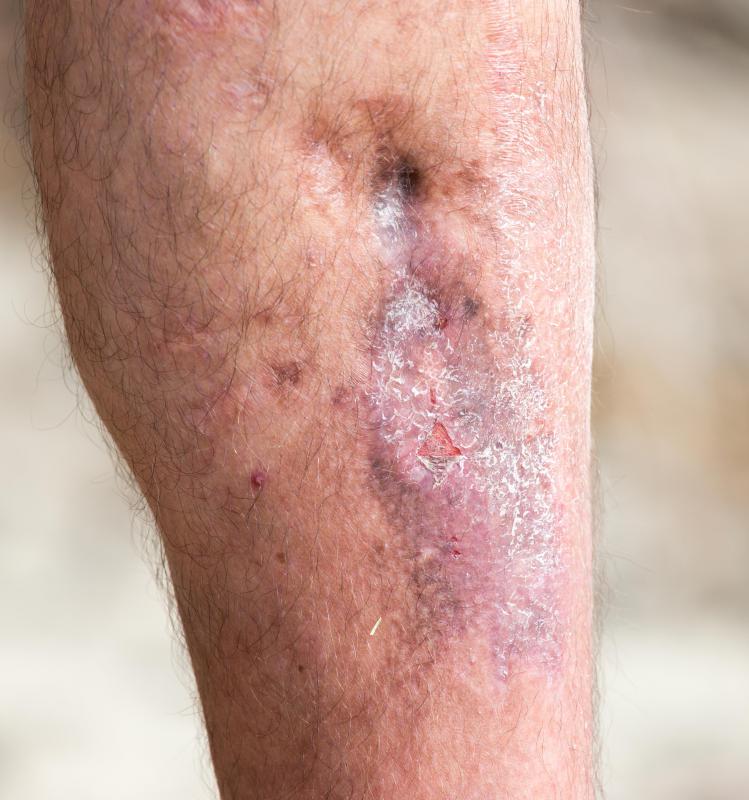At TheHealthBoard, we're committed to delivering accurate, trustworthy information. Our expert-authored content is rigorously fact-checked and sourced from credible authorities. Discover how we uphold the highest standards in providing you with reliable knowledge.
What is a Cellulitis Abscess?
A cellulitis abscess is a collection of infectious material under the skin that cannot drain, leading to the formation of a palpable lump. It is the result of untreated or poorly managed cellulitis. Eventually, the collection of material will rupture on its own, draining to the surface and potentially creating a large wound. Ideally, treatment should be provided before this occurs, so it can be safely drained and treated to limit risks for the patient and minimize scarring. A general practitioner can often provide the necessary treatment for a patient.
Cellulitis is an infection just below the surface of the skin caused by bacteria colonizing the connective tissue in the layers of skin and underlying muscle. These bacteria enter the site through small wounds, including minor cuts and scratches. As the bacteria breed, the site becomes hot, swollen, and red, and it is possible to develop a cellulitis abscess as the infection progresses.

The abscess will contain a collection of pus, waste products from bacteria, dead bacteria and skin cells, and other matter. It can be hard to the touch and will usually cause discomfort for the patient. One risk with an abscess is the possibility that it will penetrate more deeply into the body before it ruptures, allowing the bacteria to spread into locations they could not reach before. Abscesses can also cause significant scarring when they rupture on their own, as the pocket will create a deep pit in the patient's skin, as well as leaving an open wound that can be vulnerable to infection.

When a patient goes to the doctor for a cellulitis abscess, the doctor will typically recommend draining and cleaning the abscess to remove the contents and address the infection. Drains may be left in place to allow the pocket to continue draining while the patient takes a course of antibiotics to kill the infectious bacteria. Once the cellulitis is resolved and the abscess appears to be healing, the drains can be withdrawn to allow the skin to heal completely.

Patients who notice things like reddening under the skin, tenderness, and hot spots on their skin should seek medical attention. These can all be signs of cellulitis, and if the infection is not treated, potential complications include bacteremia and organ damage caused by a rampant infection. Prompt treatment can help patients avoid an unpleasant cellulitis abscess, as well as these more serious complications of infection.
AS FEATURED ON:
AS FEATURED ON:













Discussion Comments
My dog got this after getting scratched by a cat he was chasing. It was horrible! The poor thing had a baseball sized swelling on his head.
The vet had to put her on three different antibiotics before the infection cleared. With each antibiotic, the swelling reduced and then returned. That was one stubborn infection!
I also put hot compresses on the swelling which helped the pus come to the top for it to be drained.
I wouldn't wish this infection on anyone, animal or human! It really is frustrating.
@fBoyle-- I have heard of people using natural antibacterial foods like raw garlic and manuka honey to treat infections from the inside out. But I have no idea if it would be effective as an abscess treatment.
Are there any effective home remedies for cellulitis abscesses?
I had a cellulitis skin infection on my leg. It slowly swelled up, became red and hot. My doctor said it's an abscess, drained it and put me on antibiotics. It seemed to heal nicely and disappeared after several weeks.
However, it has been a few months since then I can feel it happening again on the same leg. It's not completely swollen yet but has started to look red.
I don't want to go through draining and another course of antibiotics if I don't have to. Aren't there any natural remedies that can treat this without a visit to the doctor's office?
Post your comments